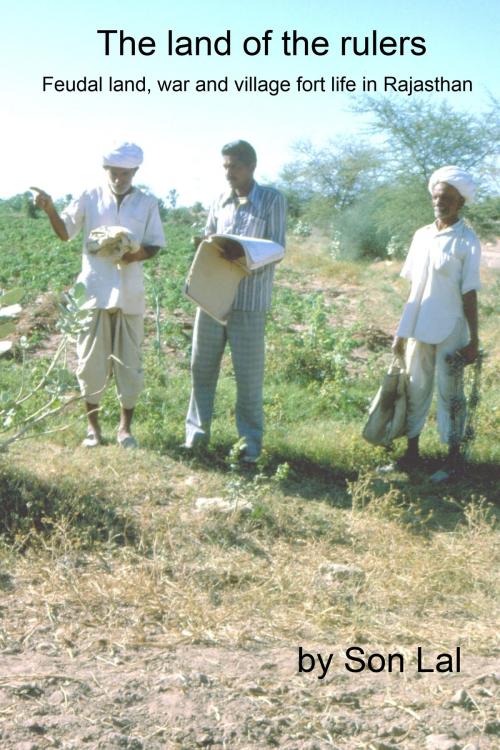| Author: | Son Lal | ISBN: | 9781310520976 |
| Publisher: | Son Lal | Publication: | February 1, 2015 |
| Imprint: | Smashwords Edition | Language: | English |
| Author: | Son Lal |
| ISBN: | 9781310520976 |
| Publisher: | Son Lal |
| Publication: | February 1, 2015 |
| Imprint: | Smashwords Edition |
| Language: | English |
Feudal land, war and village fort life in the Rajasthan desert.
A Rathore clan ruled Chelana village for a few centuries up to the end of feudal rule in 1952. Their ups and downs are narrated by Tan Dan and other sources. How the clan fought at the battle fields and how it lived at home. How the Marwar ruler granted land to the feudal elite, and the way the Chelana village lord did the same at his own village. Up to the early 19th century warfare was a major occupation of the Rathores of the Marwar state. The fate of the Rajput village clan of Chelana was closely linked to that of the ruler at Jodhpur. The feudal attitudes meant that victory and defeat both could render glory to fighting warriors. Charan bards were important in forming attitudes. The patriarchic social system paid little heed to the welfare of women living as widows and concubines. People of untouchable castes carried out forced labour under semi-slavelike conditions. The feudal land was cultivated by tenants of agricultural castes. The surplus produced was collected by the employees of the feudal elite. It was distributed to the top of the society at Jodhpur, as well as to all the feudal dependants in the village itself. The land revenue system of the Government was the base for operating the state and waging wars.
The feudal land management system in the Chelana area is described.
An elaborate administrative system with a land record accountant in every village was introduced towards the end of the feudal rule. It was borrowed from a mediaeval but efficient imperial administration at Delhi. After 1952 the land tax collected through that system was insufficient, as the Rajasthan government did not want to trouble the increasingly rich and powerful landholding farmers.
Life at the village fort was insecure, as long as the wars were frequent and Rajput warriors died at the battle fields. The men of the Rajput caste were like firefighters, sitting idle most of the time, but ready for action, if summoned. When the wars stopped after 1818 A.D., the feudal aristocrats of Chelana continued to idle away their time, living on the hard work of their tenants and forced labourers. The walled village fort was the centre of the village. There the village lord and his kinsmen ruled, and at that place all villagers gathered at big functions. There the whole village celebrated Holi. When the feudal age ended in 1952, the closely knit village life started to disintegrate. The future of the former feudal land right holders varied. Rajput landlords with no interest in agriculture did not take advantage of the irrigation farming opportunity occurring at that time. The life of the village lord family became a drama with an uncertain end.
Feudal land, war and village fort life in the Rajasthan desert.
A Rathore clan ruled Chelana village for a few centuries up to the end of feudal rule in 1952. Their ups and downs are narrated by Tan Dan and other sources. How the clan fought at the battle fields and how it lived at home. How the Marwar ruler granted land to the feudal elite, and the way the Chelana village lord did the same at his own village. Up to the early 19th century warfare was a major occupation of the Rathores of the Marwar state. The fate of the Rajput village clan of Chelana was closely linked to that of the ruler at Jodhpur. The feudal attitudes meant that victory and defeat both could render glory to fighting warriors. Charan bards were important in forming attitudes. The patriarchic social system paid little heed to the welfare of women living as widows and concubines. People of untouchable castes carried out forced labour under semi-slavelike conditions. The feudal land was cultivated by tenants of agricultural castes. The surplus produced was collected by the employees of the feudal elite. It was distributed to the top of the society at Jodhpur, as well as to all the feudal dependants in the village itself. The land revenue system of the Government was the base for operating the state and waging wars.
The feudal land management system in the Chelana area is described.
An elaborate administrative system with a land record accountant in every village was introduced towards the end of the feudal rule. It was borrowed from a mediaeval but efficient imperial administration at Delhi. After 1952 the land tax collected through that system was insufficient, as the Rajasthan government did not want to trouble the increasingly rich and powerful landholding farmers.
Life at the village fort was insecure, as long as the wars were frequent and Rajput warriors died at the battle fields. The men of the Rajput caste were like firefighters, sitting idle most of the time, but ready for action, if summoned. When the wars stopped after 1818 A.D., the feudal aristocrats of Chelana continued to idle away their time, living on the hard work of their tenants and forced labourers. The walled village fort was the centre of the village. There the village lord and his kinsmen ruled, and at that place all villagers gathered at big functions. There the whole village celebrated Holi. When the feudal age ended in 1952, the closely knit village life started to disintegrate. The future of the former feudal land right holders varied. Rajput landlords with no interest in agriculture did not take advantage of the irrigation farming opportunity occurring at that time. The life of the village lord family became a drama with an uncertain end.















